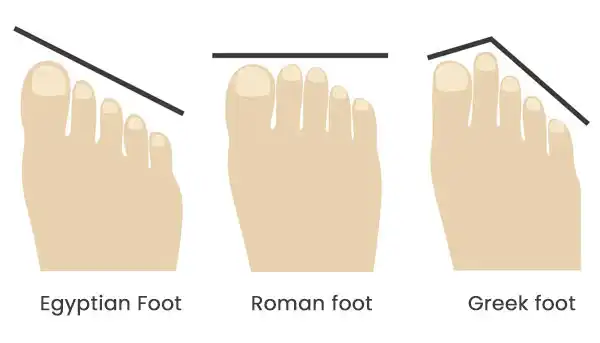The Roman Foot is an ancient unit of measurement. It played a key role in Roman engineering and architecture.
The Roman Foot, or “pes,” measured around 11. 65 inches. It was crucial in building roads, aqueducts, and landmarks that still stand today. This unit helped create a standard across the vast Roman Empire. Understanding the Roman Foot helps us appreciate the precision and skill of Roman builders.
It’s fascinating how this small unit influenced the construction of massive structures. Dive into the history and impact of the Roman Foot, and discover its lasting legacy.

Credit: footcarecentre.ie
Origins Of Roman Foot
The Roman foot, or “pes,” was a standard unit of length. It was about 11.65 inches. This measurement helped in building roads and structures. The Romans used this unit in daily life. They made sure it was consistent everywhere. This helped in trade and construction.
Many cultures influenced the Roman foot. The Greeks had their own units. Romans adopted some ideas from them. Egyptians also had an impact. Their units were slightly different. But Romans adapted these to fit their needs. This blend made the Roman foot unique. It was a mix of many cultures.

Credit: www.reddit.com
Standardization Process
The Roman Empire used the Roman Foot for measuring. This standard unit helped in building roads and buildings. People knew the size and used it often. It made trade and travel easier. It was the same everywhere. This was very important. No need to guess sizes. It was clear and simple.
Many regions adopted the Roman Foot. It became a common measure. Soldiers and builders used it. They built roads and bridges. These structures lasted a long time. It helped in making maps too. All maps had the same scale. This was very helpful. People could trust the maps.
The Roman Foot played a big role. Builders used it for planning. They measured stones and bricks. This made buildings strong. Temples and homes were built well. Roman Foot made everything fit right. It was a key part of Roman life.
Comparison With Other Units
The Roman foot was slightly shorter than the Greek foot. The Greek foot measured about 30.48 cm. The Roman foot measured around 29.6 cm. They were used for building and measuring distances. The Greek foot influenced Roman measurements. Ancient architects used both units.
The Egyptian cubit was much longer. It measured about 52.3 cm. The Roman foot was nearly half of that. Builders used the cubit for larger projects. Both units were important for their cultures. They helped in construction and land measurement.

Credit: www.reddit.com
Archaeological Evidence
Roman Foot, an ancient unit of measurement, has been confirmed through various archaeological discoveries. These findings include inscriptions, tools, and structures precisely built using this unit.
Artifacts And Inscriptions
Many artifacts and inscriptions help us understand the Roman foot. These items include statues, tools, and daily objects. Inscriptions on walls and tablets show measurements. These clues provide insight into the Roman foot’s size.
Measurement Tools
Romans used different tools to measure. One common tool was the caliper. Another was the ruler, often made from wood or metal. These tools helped ensure accuracy in building and trade.
Impact On Modern Measurements
The Roman foot has left a big mark. Many systems today still use it. For example, the foot in the Imperial system. This system is used in the UK and US. The length is close to the Roman foot. This shows a lasting legacy. Even in modern times, the Roman foot is remembered.
Engineers still look at old Roman buildings. They study the measurements. Many ideas come from the Romans. Their way of building was smart. Modern engineers use some of these old methods. It helps them make strong buildings. The Roman foot is part of this learning. It teaches good ways to measure and build. So, the impact is still strong today.
Challenges In Interpretation
Understanding the Roman foot can be tough. It varies by region. Different parts of the Roman Empire used different measurements. Some regions had longer feet. Other regions used shorter feet. This makes study difficult. Scholars need to be careful. They must check regional differences. Sometimes, records are not clear. This adds to the challenge.
Accuracy is a big problem. Ancient tools were not precise. Measurements could change over time. Wear and tear on tools caused errors. Weather and usage also affected tools. This means old measurements can be off. Scholars must consider these issues. They look for patterns. They compare many sources. This helps them find the most accurate data. But it is never perfect.
Frequently Asked Questions
What Is A Roman Foot?
A Roman foot is an ancient unit of length measurement. It is approximately equivalent to 11. 65 inches or 29. 57 centimeters.
How Long Is A Roman Foot?
A Roman foot is about 11. 65 inches or 29. 57 centimeters. It was used in ancient Rome for various measurements.
How Was A Roman Foot Used?
A Roman foot was used in construction, land measurement, and daily activities in ancient Rome. It standardized measurements.
How Does A Roman Foot Compare To A Modern Foot?
A Roman foot is slightly shorter than a modern foot. A modern foot is exactly 12 inches, while a Roman foot is 11. 65 inches.
Conclusion
Understanding the Roman foot offers a glimpse into ancient engineering. It shows the precision and skill of Roman builders. Today, its influence is evident in modern measurements. Exploring ancient units deepens our knowledge of history. It connects us to the past in a tangible way.
Appreciate the legacy of the Roman foot. Reflect on its impact on today’s world. History is fascinating, and the Roman foot is a prime example. Keep learning and discovering more about our ancient roots. Every piece of history enriches our present understanding.



